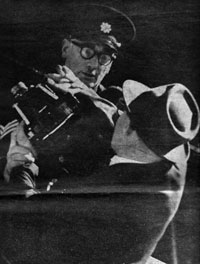9 August 2007 Edition
The Resistance Campaign 50 years on

Garda seizes camera of Irish Times photographer Edward Kelly outside Mountjoy Jail on 1 August 1957. Kelly was trying to photograph republican prisoners being taken by police tender from the jail to the Curragh Internment Camp when his camera was seized a
Mícheál MacDonncha continues a monthly series marking the 50th anniversary of the IRA’s Resistance Campaign – more widely known as the Border Campaign – which commenced in December 1956. The series will be based on the monthly republican newspaper of the time An tÉireannach Aontaithe/ The United Irishman.
Stormont imposes curfew on Newry
The predominantly nationalist town of Newry was placed under curfew by the Unionist government at Stormont in August 1957 as repression intensified in the Six Counties. In conditions of virtual martial law the RUC patrolled the town and tried to prevent people from leaving their homes during the hours of darkness. However, the ban was openly defied by the people and served only to expose the nature of the Unionist regime.
On 13 August 1957 Stormont Home Affairs Minister W.W.B. Topping invoked the Special Powers Act to impose the curfew on the town of Newry and adjacent areas in Counties Down and Armagh. People apprehended in the open between 11pm and 5.30am, unless they had special passes, were liable to jail or a fine. The RUC and British Army were empowered to shoot anyone who did not answer their challenge during the hours of darkness. Through traffic to Belfast was cut off during the curfew and all public places were to closed by 10.30pm.
The United Irishman (Meán Fómhair 1957) reported that thousands of Newry citizens defied the ban on the opening night of the curfew, many of them marching through the streets singing Amhrán na bhFiann. RUC reinforcements were brought in and baton-charged the crowds, arresting 13 people. A leaflet issued by the Republican Movement in Newry stated:
“A Stormont curfew will not stop us walking the streets of our own town in our own land. Defy the curfew. Stand together. March together. Fight together. For a united Ireland; for a free Ireland; for a democratic Ireland.”
IRA manifesto
Earlier the IRA had issued a manifesto throughout the Six Counties where it was pasted on walls in poster form. It was also distributed to governments, embassies and news agencies and Irish republicans in New York presented it to all delegates and correspondents at the United Nations. The manifesto said the Resistance campaign “is now more firmly based among our people and grows stronger by the day”. It said that attempts to portray the struggle as sectarian had failed and it was clearly a fight for national unity and independence. It regretted that the members of the RUC and B-Specials had ignored the IRA’s statement at the start of its campaign that they would not be attacked if they did not co-operate with the British Army. Now the RUC and B-Specials “have been put on a war footing and are used in conjunction with British forces”.
The issue of the manifesto coincided with a series of IRA attacks. Swatragh RUC barracks in Co. Derry was extensively damaged in a gun attack on 10 August. Many homes in the area were raided by British forces and there was a sweep of the Sperrin Mountains. In spite of this the IRA units evaded capture and attacked again on 11 August at Cranagh RUC barracks. On the same day a Royal Mail transport depot and an Electricity Board centre were destroyed in Newry. The customs post at Kinawley, County Fermanagh was also destroyed.
Meanwhile in the 26 Counties internment had been imposed in July and The United Irishman carried a list of the 115 republican prisoners interned in the Curragh Concentration Camp, Co. Kildare. Well-known names included Patrick McLogan, Anthony Magan, Ruairí Ó Brádaigh TD, Seamus Costello, Tomás MacGiolla, Dáithí Ó Conaill, Eamonn MacThomáis and Dan Gleeson. On 16 August all internees were told they would be released if they signed a form undertaking to “respect the Constitution of Ireland and the laws” and declaring that they “would not be a member of or assist any organisation which is an unlawful organisation under the Offences Against the State Act 1939”. Republicans refused to sign the form.
A notable feature of The United Irishman was its coverage of other anti-colonial struggles and it carried an extensive piece on the guerrilla army of the National Liberation Front which was then fighting the French occupation in Algeria. Torture of prisoners by the British in Cyprus was reported. And with echoes today, the paper recorded the bombing of Arab villages by the RAF in Oman and commented: “British troops are killing Arab nomads in the name of British imperialism and civilisation. The big British imperial interest in this area is oil.”


